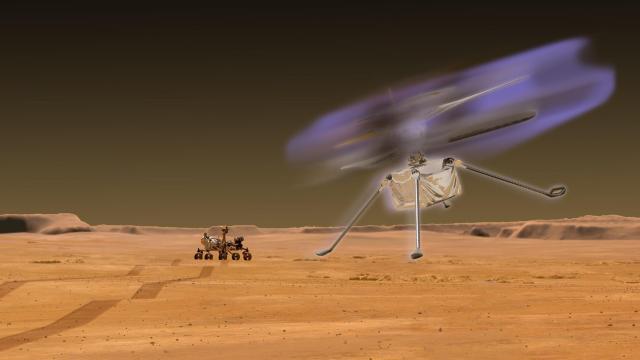The whirring of helicopter blades on Mars could create small electric fields in the Martian air, NASA scientists found, which may make the surrounding air faintly glow with a charged electric field.
The glowing effect is due triboelectric charging, which happens when friction between two objects causes charge to transfer between them. (Think the build-up of a static charge from a wool blanket). In the Martian air, this transfer happens between the helicopter blades and grains of dust in the Martian atmosphere.
When the charge is high enough, the air around the rotorcraft conducts electricity and could generate a bluish-purple plasma corona around the craft. It’s the same effect as St. Elmo’s Fire on Earth, which bamboozled sailors when the glow surrounded their ships’ masts. The recent team’s research on how the effect could occur on Mars was published in the Planetary Science Journal.
“The faint glow would be most visible during evening hours when the background sky is darker,” said William Farrell, a plasma physicist at NASA and lead author of the recent paper, in an agency release. “NASA’s experimental Ingenuity helicopter does not fly during this time, but future drones could be cleared for evening flight and look for this glow.”
Ingenuity uses a ground-facing camera in flight to navigate, making night flying impossible. It’s a pity, too, as Mars’ air is denser at night, which would make flying easier for the little helicopter. The helicopter also needs to charge up using its solar panel before the Martian night, so it typically flies earlier in the day.

Though this won’t happen to the current Mars helicopter, it may happen to future craft. The NASA researchers modelled how triboelectric charging could affect flight on the Red Planet using how charge builds up around Earth-based helicopters as a basis for their inquiry.
Because Mars’ atmosphere is just 1% as dense as Earth’s, it’s easier for the atmosphere to conduct electricity. Free electrons in the air have more space to accelerate and smash into carbon dioxide in the atmosphere, releasing more electrons and repeating the process. This cycle is called an electron avalanche; when a strong enough electric field is generated from it, the air may glow a blue-purple colour.
“In theory, there should be some effect, but whether the electron avalanche is strong enough to create a glow, and if any weak glow is observable during operations all remain to be determined in future drone flights on Mars,” Farrell said.
“In fact, one could even place small electrometers up near the blade and at the legs to monitor the effects of any charging,” he added. “This kind of electrical monitor could be of both scientific value and provide critical input on drone health during the flight.”
We may know for sure in the near future whether the rotorcrafts will glow in flight. NASA is already planning a second-generation Mars rotorcraft based on the success of Ingenuity, which started its time on Mars as a tech demonstration and now is a scout for the Perseverance rover in its quest to find ancient microbial life on the planet.
More: Perseverance Rover Has Shaken Out the Pebbles Stuck in Its Sampling System
Editor’s Note: Release dates within this article are based in the U.S., but will be updated with local Australian dates as soon as we know more.
